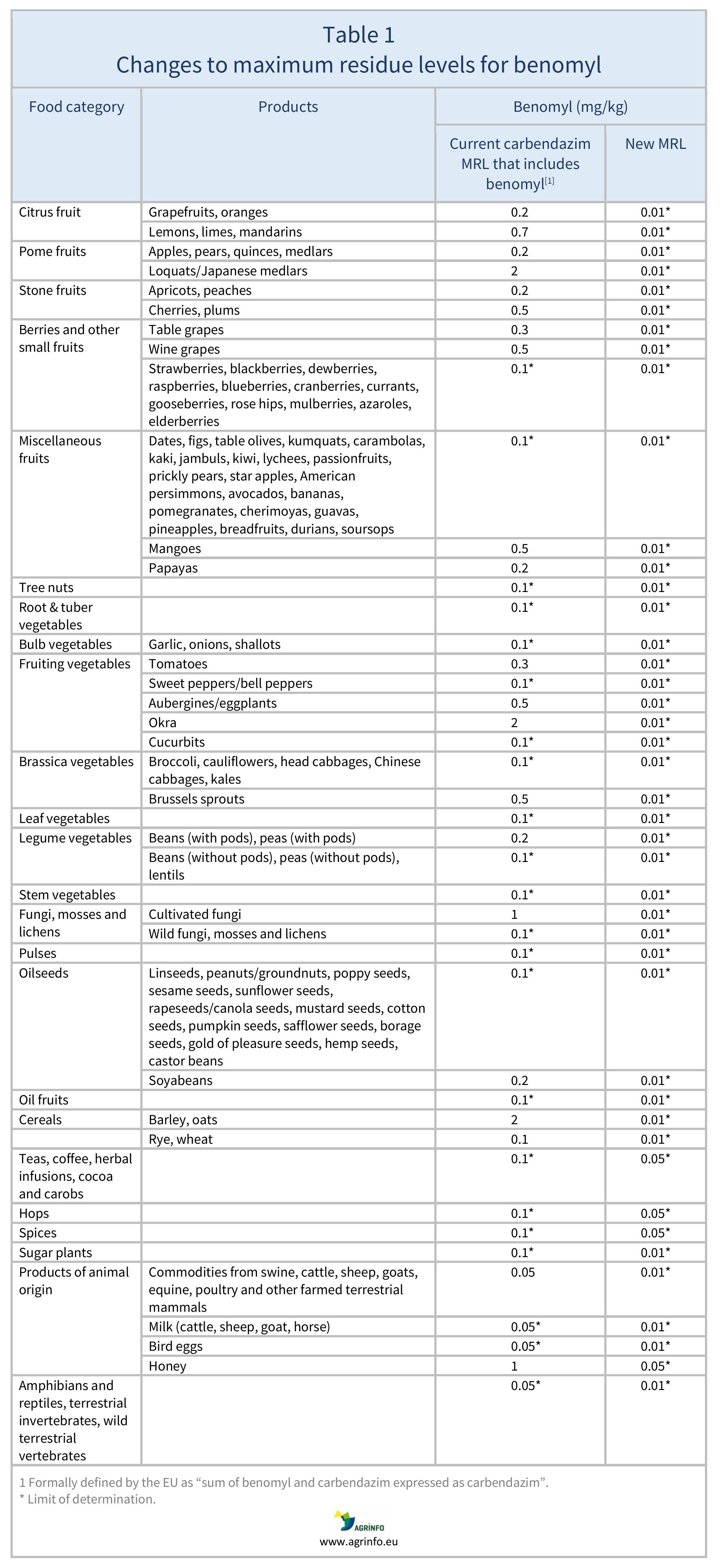Maximum residue levels for benomyl
- Pesticide MRLs
- Pesticides
Summary
In September 2024, the European Parliament rejected a Commission Regulation that proposed to set maximum residue levels (MRLs) for benomyl at the limit of determination (LOD, the lowest level that can be detected using the most modern and reliable analytical methods). See Maximum residue levels for benomyl, carbendazim, thiophanate-methyl, cyproconazole, and spirodiclofen.
Parliament rejects Commission proposal to amend MRLs for benomyl
Draft Commission Regulation amending Annexes II, III and V to Regulation (EC) No. 396/2005 of the European Parliament and of the Council as regards maximum residue levels for benomyl, carbendazim and thiophanate‐methyl in or on certain products
Update
In September 2024, the European Parliament rejected a Commission Regulation that proposed to set maximum residue levels (MRLs) for benomyl at the limit of determination (LOD, the lowest level that can be detected using the most modern and reliable analytical methods). See Maximum residue levels for benomyl, carbendazim, thiophanate-methyl, cyproconazole, and spirodiclofen.
Impacted Products
Citrus fruits, grapefruits, oranges, lemons, limes, mandarins, pome fruits, apples, pears, quinces, medlars, loquats/ Japanese medlars, stone fruits, apricots, peaches, cherries, plums, tables grapes, wine grapes, strawberries, blackberries, dewberries, raspberries, blueberries, cranberries, currants, gooseberries, rose hips, mulberries, azaroles, elderberries, tree nuts, almonds, Brazil nuts, cashew nuts, chestnuts, coconuts, hazelnuts/ cobnuts, macadamias, pecans, pine nut kernels, pistachios, walnuts, garlic, onions, shallots, tomatoes, sweet peppers/bell peppers, aubergines/ eggplants, okra, cucurbits, brassica vegetables, broccoli, cauliflowers, head cabbages, Chinese cabbages, kales, Brussels sprouts, beans (with pods), peas (with pods), beans (without pods), peas (without pods), lentils, cultivated fungi, wild fungi, mosses and lichens, oilseeds, linseeds, peanuts/ groundnuts, poppy seeds, sesame seeds, sunflower seeds, rapeseeds/ canola seeds, mustard seeds, cotton seeds, pumpkin seeds, safflower seeds, borage seeds, gold of pleasure seeds, hemp seeds, castor beans, soyabeans, barley, oat, rye, wheat, commodities from swine, bovine, sheep, goat, equine, poultry and other farmed terrestrial mammals, milk (cattle, sheep, goat, horse), bird eggs, honey, amphibians and reptiles, teas, coffees, herbal infusions, cocoa, carobs
What is changing?
Benomyl is currently included within the definition of carbendazim. The MRLs for benomyl are therefore currently the same as those for carbendazim. The Commission proposed to set specific separate MRLs for benomyl at the default level of 0.01 mg/kg for all products (except for teas, coffee, herbal infusions, cocoa, carobs, hops, spices, and honey, for which an MRL of 0.05 mg/kg would apply). The proposed changes compared to today’s carbendazim MRLs are set out in Table 1.
Why?
The European Food Safety Authority (EFSA) suggested establishing separate MRLs for benomyl and carbendazim (EFSA 2023). Benomyl is not approved as an active substance for plant protection products in the EU. Therefore no EU toxicological reference values for benomyl are available, making it challenging to assess the safety of MRLs for this substance. As benomyl lacks authorisation for use in the EU, and no import tolerances or Codex maximum residue limits (CXLs) exist, the Commission considered that the default MRL of 0.01 mg/kg should be applied (or the LOD of 0.05 mg/kg where 0.01 mg/kg cannot be achieved analytically).
Timeline
The European Parliament’s objection prevents the Commission from adopting the proposed draft Regulation, which means that the existing MRLs for carbendazim continue to apply to benomyl residues.
Background
In the EU, benomyl is currently included within the definition of carbendazim (“sum of benomyl and carbendazim expressed as carbendazim”). Products that comply with carbendazim MRLs are therefore considered to be compliant regarding benomyl. In November 2024, the European Commission informed the World Trade Organization Sanitary and Phytosanitary Measures (WTO SPS) Committee that it intended to set separate MRLs for benomyl at the default level of 0.01 mg/kg on all products, or 0.05 mg/kg where testing to 0.01 mg/kg is not technically possible (G/SPS/N/EU/696).
MRLs are set in accordance with the rules set out in Regulation 396/2005. For information on current MRLs for other substances, please consult the EU Pesticide Residues database.
Resources
EFSA (2023) Reasoned opinion on the toxicological properties and maximum residue levels (MRLs) for the benzimidazole substances carbendazim and thiophanate-methyl. EFSA Journal 19(8): 6773.
Sources
Draft Commission Regulation amending Annexes II, III and V to Regulation (EC) No. 396/2005 of the European Parliament and of the Council as regards maximum residue levels for benomyl, carbendazim and thiophanate‐methyl in or on certain products
Tables & Figures

Source: based on PLAN/2022/2853
Disclaimer: Under no circumstances shall COLEAD be liable for any loss, damage, liability or expense incurred or suffered that is claimed to have resulted from the use of information available on this website or any link to external sites. The use of the website is at the user’s sole risk and responsibility. This information platform was created and maintained with the financial support of the European Union. Its contents do not, however, reflect the views of the European Union.
Parliament rejects Commission proposal to amend MRLs for benomyl
Draft Regulation as regards maximum residue levels for benomyl, carbendazim and thiophanate‐methyl in or on certain products
What is changing and why?
In September 2024, the European Parliament rejected a Commission Regulation that proposed to set maximum residue levels (MRLs) for benomyl on all products at the limit of determination (LOD, the lowest level that can be detected using the most modern and reliable analytical methods) as indicated in Table 1.
Timeline
The Parliament’s objection prevents the Commission from adopting the proposed draft Regulation, which means that the existing MRLs for carbendazim continue to apply to benomyl residues.
Tables & Figures

Source: based on PLAN/2022/2853
Disclaimer: Under no circumstances shall COLEAD be liable for any loss, damage, liability or expense incurred or suffered that is claimed to have resulted from the use of information available on this website or any link to external sites. The use of the website is at the user’s sole risk and responsibility. This information platform was created and maintained with the financial support of the European Union. Its contents do not, however, reflect the views of the European Union.
